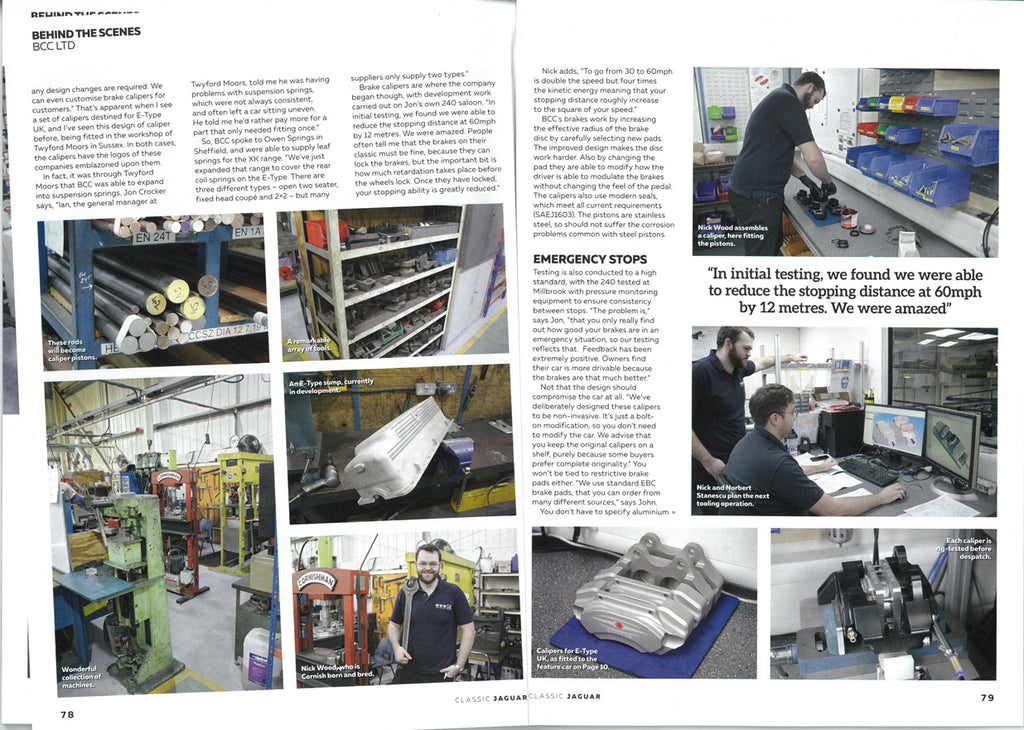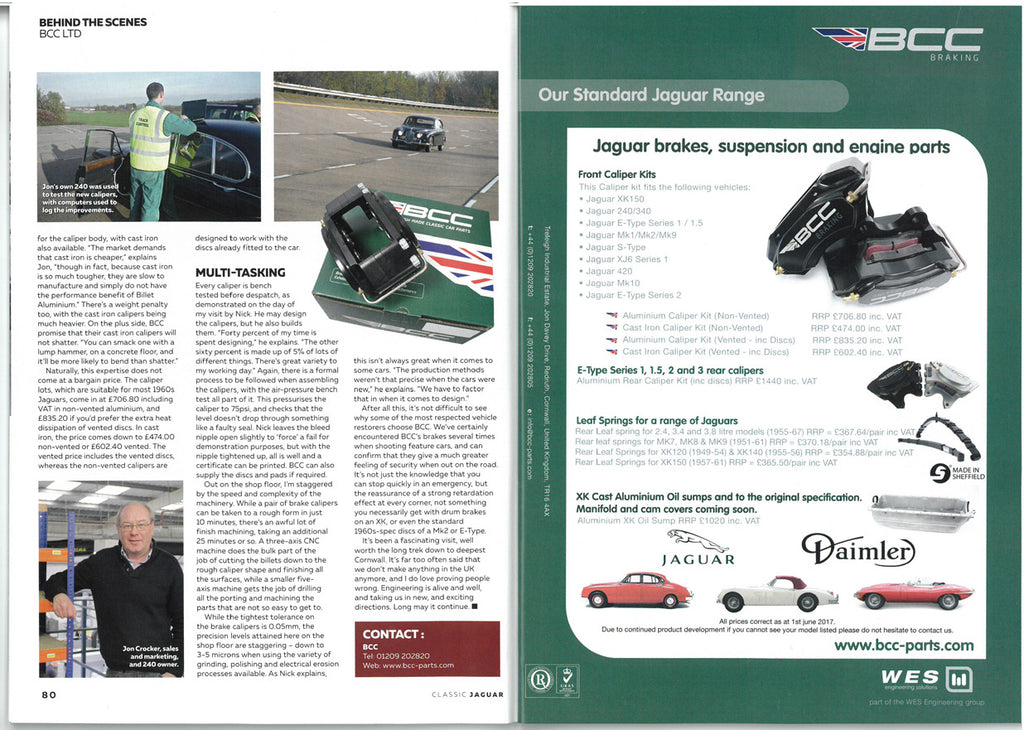Classic Jaguar Magazine Visit BCC - MEET THE SPECIALISTS
Classic Jaguar - Apr/May Edition

We trek down to Redruth in Cornwall, to visit a young, but very exciting company building brake and suspension parts. Who are BCC?
Words and pics: Ian Seabrook
“We can take a billet of aluminium and turn it into two halves of a brake caliper in about 24 minutes,” enthuses product manager Nick Wood. He is twenty years old, but despite the fact I’ve been inside the factory for all of about five minutes, his enthusiasm is already boiling over, as he displays a knowledge of engineering way in excess of my own.
Nick is showing the computer software that makes this remarkable feat possible, with huge machines computer controlled for maximum precision and repeatability. Every step of the journey of a brake caliper’s life can be traced right back, right down to the original billet of aluminium, but while BCC is relatively new on the classic scene, the calipers are actually produced WES Engineering Solutions, which has a far longer history.
Andrew Hosking Engineering was set up by Andrew in 1983, when he was a sole trader. WES (Welding Electrode Store Ltd) was formed in 1989, specialising in the electrodes required by welding robots in car factories – The Rover Group, Honda, BMW and Nissan have all been (and in some cases remain) happy customers. In 1999, the two companies moved to the current factory in Redruth, with WES Ltd becoming the sole company.
Hardmetal Engineering was purchased in 2006, with BCC Ltd purchased in 2015
(CHECK). WES, Hardmetal Engineering and BCC are now part of an overall holding group, but the important bit is that BCC markets and designs brake calipers and springs for classic cars, while WES and Hardmetal Engineering actually make them. All the companies are based at the Redruth site, which houses 54 employees, with 39 of those on the shop floor, and seven or eight apprentices. James Gazzard, who looks after the sales and marketing of the WES group, said, “We’re very keen to invest in the future, and have schemes in place with several local colleges. Over the past ten years, we’ve reduced the
average age of our workforce by ten years.”
BCC itself consists of only two employees – Jon Crocker, who is responsible for selling and marketing BCC’s parts, and Nick Wood, who is responsible for designing them. Nick works with Norbert Stanescu, the project product engineer at WES, who is ultimately responsible for telling the machines what to do. His job involves planning how these mighty machines will tackle the metal, shaping them into the various brake calipers. The computer software even enables him to run animations of how the work will be carried out. It’s a fairly unique situation, with all the design work done in the same building as the manufacture. Nick says, “It allows us to respond very quickly if any design changes are required. We can even customise brake calipers for customers.” That’s apparent when I see a set of calipers destined for E-Type UK, and I’ve seen this design of caliper before, being fitted in the workshop of Twyford Moors in Sussex. In both cases, the calipers have the logos of these companies emblazoned upon them.

In fact, it was through Twyford Moors that BCC was able to expand into suspension springs. Jon Crocker says, “Ian, the general manager at Twyford Moors, told me he was having problems with suspension springs, which were not always consistent, and often left a car sitting uneven. He told me he’d rather pay more for a part that only needed fitting once.”
So, BCC spoke to Owen Springs in Sheffield, and were able to supply leaf springs for the XK range. “We’ve just expanded that range to cover the rear coil springs on the E-Type. There are three different types – open two seater, fixed head coupé and 2+2 – but many suppliers only supply two types.” Brake calipers are where the company began though, with development work carried out on Jon’s own 240 saloon. “In initial testing, we found we were able to reduce the stopping
distance at 60mph by 12 metres. We were amazed. People often tell me that the brakes on their classic must be fine, because they can lock the brakes, but the important bit is how much retardation takes place before the wheels lock. Once they have locked, your stopping ability is greatly reduced.”
Nick adds, “To go from 30 to 60mph is double the speed but 4 times the kinetic energy meaning that your stopping distance roughly increase to the square of your speed” BCC’s brakes work by increasing the effective radius of the brake disc by carefully selecting a new brake pads. This therefore making the disc work harder. Also by changing the pad they are able to modify how the driver is able to modulate the brakes without changing the feel of the pedal. The calipers also use modern seals, which meet all current requirements (SAEJ1603). The pistons are stainless steel, so should not suffer the corrosion problems common with steel pistons. Testing is also conducted to a high standard, with the 240 tested at Millbrook with pressure monitoring equipment to ensure consistency between stops. “The problem is,” says Jon, “that you only really find out how good your brakes are in an emergency situation, so our testing reflects that. Feedback has been extremely positive. Owners find their car is more drivable because the brakes are that much better.”
Not that the design should compromise the car at all. “We’ve deliberately designed these calipers to be non-invasive. It’s just a bolt-on modification, so you don’t need to modify the car. We advise that you keep the original calipers on a shelf, purely because some buyers prefer complete originality.” You won’t be tied to restrictive brake pads either. “We use standard EBC brake pads, that you can order from many different sources,” says John.
You don’t have to specify aluminium for the caliper body, with cast iron also available. “The market demands that cast iron is cheaper,” explains Jon, “though in fact, because cast iron is so much tougher they are slow to manufacture cast iron calipers are much more difficult to make and simply do not have the performance benefit of Billet Aluminium.” There’s a weight penalty too, with the cast iron calipers being much heavier. On the plus side, BCC promise that their cast iron calipers will not shatter. “You can smack one with a lump hammer, on a concrete floor, and it’ll be more likely to bend than shatter.”
Naturally, this expertise does not come at a bargain price. The caliper lots, which are suitable for most 1960s Jaguars, comes in at £706.80 including VAT in non-vented aluminium, and £835.20 if you’d prefer the extra heat dissipation of vented discs (which will be extra on top of course). In cast iron, the price comes down to £474.00 non-vented or £602.40 vented which includes the discs.
Every caliper is bench tested before despatch, as demonstrated on the day of my visit by Nick. He may design the calipers, but he also builds them. “Forty percent of my time is spent designing,” he explains. “The other sixty percent is made up of 5% of lots of different things. There’s great variety to my working day.” Again, there is a formal process to be followed when assembling the calipers, with the air-pressure bench test all part of it. This pressurises the caliper to 75psi, and checks that the level doesn’t drop through something like a faulty seal. Nick leaves the bleed nipple open slightly to ‘force’ a fail for demonstration purposes, but with the nipple tightened up, all is well and a certificate can be printed. BCC can also supply the discs and pads if required.
Out on the shop floor, I’m staggered by the speed and complexity of the machinery. While an axle pair of brake calipers can be taken to a rough form in just 10 minutes, there’s an awful lot of finish machining taking an additional 25minutes or so. A three-axis CNC machine does the bulk part of the job of cutting the billets down to the rough caliper shape and finishing all the surfaces. while a smaller five-axis machine gets the job of drilling all the porting and machining the parts that are not so easy to get to.
While the tightest tolerance on the brake calipers is .05mm, the precision levels attained here on the shop floor are staggering – down to 3-5 microns when using the variety of grinding, polishing and electrical erosion processes available. As Nick explains, this isn’t always great when it comes to some cars. “The production methods weren’t that precise when the cars were new,” he explains. “We have to factor that in when it comes to design.”

After all this, it’s not difficult to see why some of the most respected vehicle restorers choose BCC. We’ve certainly encountered BCC’s brakes several times when shooting feature cars, and can confirm that they give a much greater feeling of security when out on the road. It’s not just the knowledge that you can stop quickly in an emergency, but the reassurance of a strong retardation effect at every corner, not something you necessarily get with drum brakes on an XK, or even the standard 1960s-spec discs of a Mk2 or E- Type. It’s been a fascinating visit, well worth the long trek down to deepest Cornwall. It’s far too often said that we don’t make anything in the UK anymore, and I do love proving people wrong. Engineering is alive and well, and taking us in new, and exciting directions. Long may it continue.


